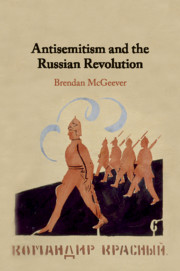Book contents
- Antisemitism and the Russian Revolution
- Antisemitism and the Russian Revolution
- Copyright page
- Contents
- Figures
- Acknowledgements
- A Note on Translation
- Terms and Abbreviations
- Introduction
- 1 1917: Antisemitism in the Moment of Revolution
- 2 ‘Red Pogroms’: Spring 1918
- 3 The Soviet Response to Antisemitism, 1918
- 4 Antisemitism and Revolutionary Politics: the Red Army in Ukraine, 1919
- 5 The Soviet Response to Antisemitism in Ukraine, February–May 1919
- 6 Jewish Communists and the Soviet Response to Antisemitism, May–December 1919
- 7 Reinscribing Antisemitism?
- Epilogue: In the Shadow of Pogroms
- Conclusions: Anti-Racist Praxis in the Russian Revolution
- Bibliography
- Index
Epilogue: In the Shadow of Pogroms
Published online by Cambridge University Press: 16 September 2019
- Antisemitism and the Russian Revolution
- Antisemitism and the Russian Revolution
- Copyright page
- Contents
- Figures
- Acknowledgements
- A Note on Translation
- Terms and Abbreviations
- Introduction
- 1 1917: Antisemitism in the Moment of Revolution
- 2 ‘Red Pogroms’: Spring 1918
- 3 The Soviet Response to Antisemitism, 1918
- 4 Antisemitism and Revolutionary Politics: the Red Army in Ukraine, 1919
- 5 The Soviet Response to Antisemitism in Ukraine, February–May 1919
- 6 Jewish Communists and the Soviet Response to Antisemitism, May–December 1919
- 7 Reinscribing Antisemitism?
- Epilogue: In the Shadow of Pogroms
- Conclusions: Anti-Racist Praxis in the Russian Revolution
- Bibliography
- Index
Summary
By the early 1920s, the architects of the Soviet confrontation with antisemitism had left the scene. After his expulsion from the Jewish Commissariat in 1918, Zvi Fridliand continued to lead the Poalei Zion party, before eventually joining the Bolsheviks in 1921. Shortly after, he became a professor of French history, and later, the first dean of Moscow University. In the course of the 1920s, he mostly left the question of antisemitism to one side. Seconded to work for the Comintern in China, Moishe Rafes also moved away from Soviet Jewish politics after the Civil War. Abram Kheifets followed a similar path, and moved to Germany under the auspices of the Comintern, where he later joined the German Communist Party under the name ‘August Kleine’. In the 1920s, David Lipets found a new life too: now known as ‘Petrovskii’, he became a decorated general in the Red Army. The territorialist David Davidovich (L’vovich) had been the first to raise the question of antisemitism to the Soviet government in April 1918. Unlike the others, he deepened his immersion in the fate of Soviet Jewry, but did so from a distance, as Director of the ORT in Berlin and Paris. Of the core activists who initiated and then led the Soviet response to antisemitism, only Dimanshtein remained within the Evsektsiia orbit by the end of the Civil War.
- Type
- Chapter
- Information
- Antisemitism and the Russian Revolution , pp. 211 - 215Publisher: Cambridge University PressPrint publication year: 2019



